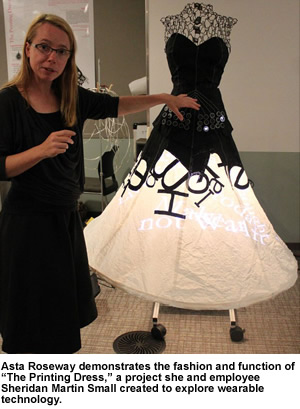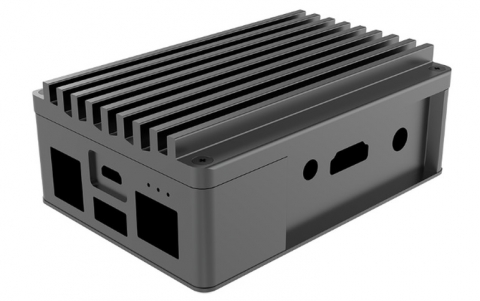
Microsoft Breaks Through with Wearable Technology Concept
Microsoft designers have created "The Printing Dress," a wearable
technology creation that's turning heads in design circles.
 "The Printing Dress," a project created by Microsoft
Research's Asta Roseway and Xbox?s Sheridan Martin Small, is one of
the first pieces of fashion technology to emerge from the company.
The women and their dress won Best Concept and Best in Show at the
15th annual International Symposium on Wearable Computers (ISWC) in
San Francisco this June.
"The Printing Dress," a project created by Microsoft
Research's Asta Roseway and Xbox?s Sheridan Martin Small, is one of
the first pieces of fashion technology to emerge from the company.
The women and their dress won Best Concept and Best in Show at the
15th annual International Symposium on Wearable Computers (ISWC) in
San Francisco this June.
The dress is high-fashion, high-concept, and totally high-tech. It's made almost entirely of black and white rice paper. Sewn into the bodice are laser-cut buttons, reminiscent of old-fashioned typewriter keys. Though the style of the dress is old-meets-new, the rest of it is anything but old-fashioned - it comes equipped with a laptop, a projector, and four circuit boards. Everything is functional, from buttons to hem.
Though it's a prototype not meant to be worn, the dress's wearer could theoretically type messages on the bodice keyboard, and those messages would be projected onto the skirt for the world to see.
"The biggest win out of this dress wasn't winning at the symposium, it's the fact that it's a conversation piece now," Roseway says.
Roseway's colleagues in Microsoft Research are excitedly exploring soft displays and fabric technology. The Microsoft Research hardware team is even talking about buying a loom.
"It was hugely collaborative, which is what made it a win for everyone," Roseway says. "My hope is that it will create segues into other projects. But just the fact that so many people are now talking about wearable technology is a victory."
 "The Printing Dress," a project created by Microsoft
Research's Asta Roseway and Xbox?s Sheridan Martin Small, is one of
the first pieces of fashion technology to emerge from the company.
The women and their dress won Best Concept and Best in Show at the
15th annual International Symposium on Wearable Computers (ISWC) in
San Francisco this June.
"The Printing Dress," a project created by Microsoft
Research's Asta Roseway and Xbox?s Sheridan Martin Small, is one of
the first pieces of fashion technology to emerge from the company.
The women and their dress won Best Concept and Best in Show at the
15th annual International Symposium on Wearable Computers (ISWC) in
San Francisco this June.
The dress is high-fashion, high-concept, and totally high-tech. It's made almost entirely of black and white rice paper. Sewn into the bodice are laser-cut buttons, reminiscent of old-fashioned typewriter keys. Though the style of the dress is old-meets-new, the rest of it is anything but old-fashioned - it comes equipped with a laptop, a projector, and four circuit boards. Everything is functional, from buttons to hem.
Though it's a prototype not meant to be worn, the dress's wearer could theoretically type messages on the bodice keyboard, and those messages would be projected onto the skirt for the world to see.
"The biggest win out of this dress wasn't winning at the symposium, it's the fact that it's a conversation piece now," Roseway says.
Roseway's colleagues in Microsoft Research are excitedly exploring soft displays and fabric technology. The Microsoft Research hardware team is even talking about buying a loom.
"It was hugely collaborative, which is what made it a win for everyone," Roseway says. "My hope is that it will create segues into other projects. But just the fact that so many people are now talking about wearable technology is a victory."





















